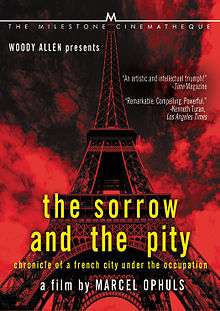The Sorrow and the Pity
| The Sorrow and the Pity | |
|---|---|
 Movie poster | |
| Directed by | Marcel Ophüls |
| Written by |
Marcel Ophüls André Harris |
Release dates | September 18, 1969 |
Running time | 251 min. |
| Language | French/German/English |
The Sorrow and the Pity (French: Le Chagrin et la Pitié) is a two-part 1969 documentary film by Marcel Ophüls about the collaboration between the Vichy government and Nazi Germany during World War II. The film uses interviews with a German officer, collaborators, and resistance fighters from Clermont-Ferrand. They comment on the nature of and reasons for collaboration. The reasons include antisemitism, anglophobia, fear of Bolsheviks and Soviet invasion, the desire for power, and simple caution.
Synopsis
Part One of the film, The Collapse, has an extended interview with Pierre Mendès France. He was jailed by the Vichy government on charges of desertion, but escaped from jail to join Charles de Gaulle's forces operating out of England, and later served as Prime Minister of France for eight months from 1954 to 1955.
Part Two, The Choice, revolves around Christian de la Mazière, who is something of a counterpoint to Mendès France. Whereas Mendès France was a French Jewish political figure who joined the Resistance, de la Mazière, an aristocrat who embraced Fascism, was one of 7,000 French youth to fight on the Eastern Front wearing German uniforms.
The film shows the French people's response to occupation as heroic, pitiable, and monstrous—sometimes all at once. The postwar humiliation of the women who served (or were married to) Vichy men perhaps gives the strongest mix of all three. Maurice Chevalier's "Sweepin' the Clouds Away" is the theme song of the film.
Interviewees
Persons interviewed for the film
- Georges Bidault
- Matthäus Bleibinger
- Charles Braun
- Maurice Buckmaster
- Emile Coulaudon
- Emmanuel d'Astier de la Vigerie
- Comte René de Chambrun
- Christian de la Mazière
- Jacques Duclos
- Colonel Raymond Du Jonchay
- Anthony Eden
- Marcel Fouche-Degliame
- Raphaël Géminiani
- Alexis Grave
- Louis Grave
- Marius Klein
- Georges Lamirand
- Pierre Le Calvez
- Claude Levy
- Pierre Mendès France
- Elmar Michel
- Denis Rake
- Henri Rochat
- Paul Schmidt
- Edward Spears
- Helmut Tausend
- Roger Tounze
- Marcel Verdier
- Walter Warlimont
Persons present or speaking in archival footage
Release
This film was first shown on French television in 1981 after being banned from that medium for years. It is frequently assumed that the reason was French reluctance to admit the facts of French history. While this may have been a factor, the principal mover in the decision was Simone Veil, a Jewish inmate of Auschwitz who became a minister and the first President of the European Parliament, on the grounds that the film presented too one-sided a view.[1]
Reception
TIME magazine gave a positive review of the film, and wrote that Marcel Ophüls "tries to puncture the bourgeois myth—or protectively askew memory—that allows France generally to act as if hardly any Frenchmen collaborated with the Germans."[2] It was nominated for an Academy Award in 1971 for Best Documentary Feature.[3]
In popular culture
Woody Allen's film Annie Hall (1977) makes several references to The Sorrow and the Pity as part of the main character's obsession with the persecution of Jews during World War II.[4]
References
- ↑ Simone Veil, Mémoires, Paris, 2008
- ↑ Monday, Mar. 27, 1972 (1972-03-27). "TIME magazine: Truth and Consequences". Time.com. Retrieved 2012-08-27.
- ↑ "NY Times: The Sorrow and the Pity". NY Times. Retrieved 2008-11-12.
- ↑ "Annie Hall Film Script". DailyScript.com. Retrieved 2015-01-27.
External links
- The Sorrow and the Pity at the Internet Movie Database
- The Sorrow and the Pity at AllMovie
- The Sorrow and the Pity at Rotten Tomatoes
- (French) (English) Testimony File - History of the resistance of the Strasbourg French University transferred to Clermont-Ferrand